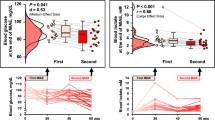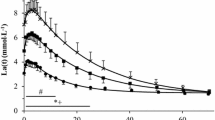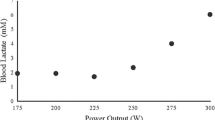Summary
In an attempt to develop a submaximal exercise test protocol for the evaluation of physical work capacity, the blood lactate responses to an incremental and an acute exercise protocol have been investigated. Twelve males performed two cycle ergometer exercise tests: (1) a continuous, incremental (IncEx) protocol with 50 W steps every 4 min to exhaustion; (2) an acute exercise bout (AcEx) for 7 min at 200 W. Blood lactate concentration was determined for every stage of the IncEx protocol and after 4, 5, 6, and 7 min of the AcEx protocol. Time to exhaustion was correlated with the power output calculated to elicit 4 mmol×l−1 blood lactate with IncEx and with the lactate concentration measured 6 min after the onset of AcEx. These two parameters were related to both the percentage of slow twitch fibres and the capillary density in the M. vastus lateralis. The data are interpreted as suggesting that, with regard to lactate accumulation during IncEx, training status starts to exert its effects at relatively low exercise intensities. In addition, those factors which contribute to a delay in lactate accumulation during IncEx also contribute to the ability to avoid high blood lactate concentrations after AcEx. The lactate response to an acute, submaximal exercise bout offers a viable alternative to maximal exercise testing for mass testing of endurance.
Similar content being viewed by others
References
Andersen P (1975) Capillary density in skeletal muscle of man. Acta Physiol Scand 95: 203–205
Ahlborg B, Linroth K, Nordgren B, Schéle R (1973) Ett hÄlsooch kapacitetsundersökningssystem för personalselektion. Försvarsmedicin 9: 36–52
Bang O (1936) The lactate content of the blood during and after muscular exercise in man. Skand Arch Physiol [Suppl 10] 74: 51–82
Bergström J (1962) Muscle electrolytes in man. Scand J Clin Lab Invest [Suppl] 68
Brooke MH, Kaiser KK (1970) Three “myosin adenosine triphosphatase” systems: the nature of their pH lability and sulfhydryl dependence. J Histochem Cytochem 18: 670–672
Cerretelli P, Pendergast D, Paganelli WC, Rennie DM (1979) Effects of specific muscle training on \(\dot V\)O2 on-response and early blood lactate. J Appl Physiol: Respirat Environ Exercise Physiol 47: 761–769
Ekblom B, åstrand P-O, Saltin B, Stenberg J, Wallström B (1968) Effect of training on circulatory response to exercise. J Appl Physiol 24: 518–528
Farrell PA, Wilmore J, Coyle E, Billing J, Costill D (1979) Plasma lactate accumulation and distance running performance. Med Sci Sports 11: 338–344
Föhrenback R, Mader A, Hollman W (1981) Umfang und IntensitÄt im Dauerlauftraining von MittelstreckenlÄuferinnen des DLV und Ma\nahmen zur individuellen Trainings- und Wettkampfoptimierung. Leistungssport 11: 458–472
Guth L, Samaha F (1970) Procedures for the histochemical demonstration of actomyosin ATPase. Exp Neurol 28: 365–367
Hickson RC, Bomze HA, Holoszy JO (1978) Faster adjustment of O2 uptake to the energy requirement of exercise in the trained state. J Appl Physiol: Respirat Environ Exercise Physiol 44: 877–881
Hollman W, Liesen H, Mader A, Heck H, Rost R, Dufaux B, Schürch P, Lagerström D, Föhrenback R (1981) Zur Höchst- und DauerleistungsfÄhigkeit der deutschen Fu\ball-Spit-zenspieler. Dtsch Z Sportmedizin 32: 113–120
Ivy J, Withers R, van Handel P, Elger D, Costill D (1980) Muscle respiratory capacity and fiber type as determinants of the lactate threshold. J Appl Physiol: Respirat Environ Exercise Physiol 48: 523–527
Jacobs I (1981) Lactate, muscle glycogen and exercise performance in man. Acta Physiol Scand [Suppl] 495
LaFontaine TP, Londeree BR, Spath WK (1981) The maximal steady state versus selected running events. Med Sci Sports Exerc 13: 190–193
Karlsson J, Nordesjö L-O, Jorfeldt L, Saltin B (1972) Muscle lactate, ATP, and CP levels during exercise after physical training in man. J Appl Physiol 33: 199–203
Mader A, Liesen H, Heck H, Philippi H, Rost R, Schürch P, Hollman W (1976) Zur Beurteilung der sportartspezifischen AusdauerleistungsfÄhigkeit im Labor. Sportarzt und Sportmedizin 27: 109–112
Nordesjö L-O (1974) Estimation of the maximal work rate sustainable for 6 min using a single-level load or stepwise increasing loads. Upsala J Med Sci 79: 45–50
Nordesjö L-O, Schéle R (1974) Validity of an ergometer cycle test and measures of isometric muscle strength when predicting some aspects of military performance. Försvarsmedicin 10: 11–23
Roth V, Pansold B, Hasart E, Zinner J, Gabriel B (1981) Zum Informationsgehalt leistungsdiagnostischer Parameter in AbhÄngigkeit von der Zunahme der LeistungsfÄhigkeit bei Sportlern. Med Sport 21: 326–336
Rydevik U, Nord L, Ingman F (1982) Automatic lactate determination by flow injection analysis. Int J Sports Med 3: 47–49
Schéle R, Ahlborg B, Ekbom K (1978) Physical characteristics and allergic history in young men with migraine and other headaches. Headache 18: 80–86
Sjödin B, Jacobs I (1981) Onset of blood lactate accumulation and marathon running performance. Int J Sports Med 2: 23–26
Sjödin B, Jacobs I, Karlsson J (1981) Onset of blood lactate accumulation and enzyme activities in M. vastus lateralis in man. Int J Sports Med 2: 166–170
Sjödin B, Jacobs I, Svedenhag J (1982) Changes in onset of blood lactate accumulation (OBLA) and muscle enzymes after training at OBLA. Eur J Appl Physiol 49: 45–57
Stegmann H, Kindermann W (1982) Comparison of prolonged exercise tests at the individual anaerobic threshold and the fixed anaerobic threshold of 4 mmol·l−1. Int J Sports Med 3: 105–110
Tesch PA, Sharp DS, Daniels WL (1981) Influence of fiber type composition and capillary density on onset of blood lactate accumulation. Int J Sports Med 2: 252–255
Tornvall G (1963) Assessment of physical capabilities. Acta Physiol Scand [Suppl] 201
Wasserman K, Whipp BJ (1975) Exercise physiology in health and disease. Am Rev Respir Dis 112: 219–249
Weltman A, Katch V (1976) Minute-by-minute respiratory exchange and oxygen uptake kinetics during steady state exercise in subjects of high and low max \(\dot V\)O2. Res Q 47: 490–498
Author information
Authors and Affiliations
Rights and permissions
About this article
Cite this article
Jacobs, I., Sjödin, B. & Schéle, R. A single blood lactate determination as an indicator of cycle ergometer endurance capacity. Europ. J. Appl. Physiol. 50, 355–364 (1983). https://doi.org/10.1007/BF00423241
Accepted:
Issue Date:
DOI: https://doi.org/10.1007/BF00423241




